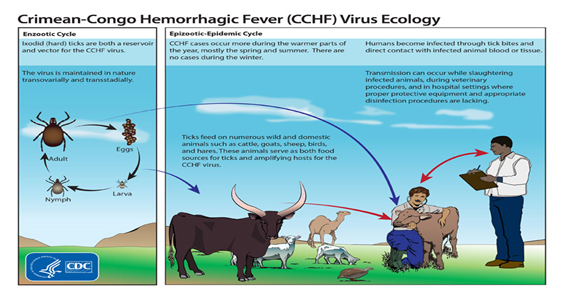

Context
According to the World Health Organization (WHO), rising temperatures in Europe have also raised fears of spread of viruses generally not found in colder climates namely includes Crimean-Congo haemorrhagic fever (CCHF), an infection spread by ticks that has a high fatality rate.
- In June 2023, a person got infected from the Crimean-Congo haemorrhagic fever in Gujarat whose vaccine is still not made.
Background
- The CCHF is endemic to Africa, the Balkan countries, Middle East, and parts of Asia.
- The first fatality from the disease in Europe was in Spain, in 2016.
- Scientists are now warning that CCHF, which can kill between 10% and 40% of patients, is spreading northward and westward in Europe.
About Crimean-Congo haemorrhagic fever (CCHF):
- Crimean-Congo haemorrhagic fever (CCHF) is a viral haemorrhagic fever usually transmitted by ticks.
- It can also be contracted through contact with viraemic animal tissues (animal tissue where the virus has entered the bloodstream) during and immediately post-slaughter of animals.
- Vector of the spread: ‘Ticks’, especially those of the genus, Hyalomma, are both a reservoir and a vector for the CCHF virus.
- Numerous wild and domestic animals, such as cattle, goats, sheep and hares, serve as amplifying hosts for the virus.
- Transmission to humans occurs through contact with infected ticks or animal blood.
- CCHF outbreaks constitute a threat to public health services as the virus can lead to epidemics, has a high case fatality ratio (10–40%), potentially results in hospital and health facility outbreaks, and is difficult to prevent and treat.

- Symptoms:
- CCHF symptoms include fever, muscle ache, dizziness, neck pain, backache, headache, sore eyes and sensitivity to light.
- There may be nausea, vomiting, diarrhoea, abdominal pain and sore throat early on, followed by sharp mood swings and confusion.
- After 2–4 days the agitation may be replaced by sleepiness, depression and lassitude.
- Treatment:
- There is no vaccine for the virus in either humans or animals, and treatment generally consists of managing symptoms.
|
According to the WHO, “the antiviral drug ribavirin has been used to treat CCHF infection with apparent benefit.” |
How Climate Change contribute to spread of Viruses?
- As temperature patterns are disrupted, pathogens are thriving in geographies that traditionally had a climate hostile to them.
- Climate change contributes to the spread of diseases in multiple ways, including:
- Warmer temperatures expanding the habitat of ticks and other insects and giving them more time to reproduce;
- The habitat offered by water undergoing changes; and
- Animals moving to newer areas and people coming into contact with them.

Effects of rising temperature on Microorganism:
- According to a study, an increase in temperature will increase enzyme activity. But if temperatures get too high, enzyme activity will reduce, and the protein (the enzyme) will denature.
- On the other hand, lowering temperature will decrease enzyme activity.
- In general, the higher the temperature, the more easily microorganisms can grow up to a certain point.
- Very high and low temperatures both obstruct the enzyme processes microorganisms depend on to survive.
Survival of Microorganism in high Temperature:
- Generally, microorganisms with an optimal growth temperature (OGT) between 60 and 80°C are designated as thermophiles, whereas those growing optimally at temperatures of >80°C are referred to as hyperthermophiles, which are found in the three domains of life, archaea, bacteria, and eukarya, but the majority are archaea and bacteria.
- Environmental changes such as temperature shifts induce genomic evolution, which in turn provides the bacteria with thermal-tolerant abilities to survive under high temperatures.
- Such evolutionary changes could be achieved through horizontal gene transfer (HGT), gene loss, or gene mutations.


